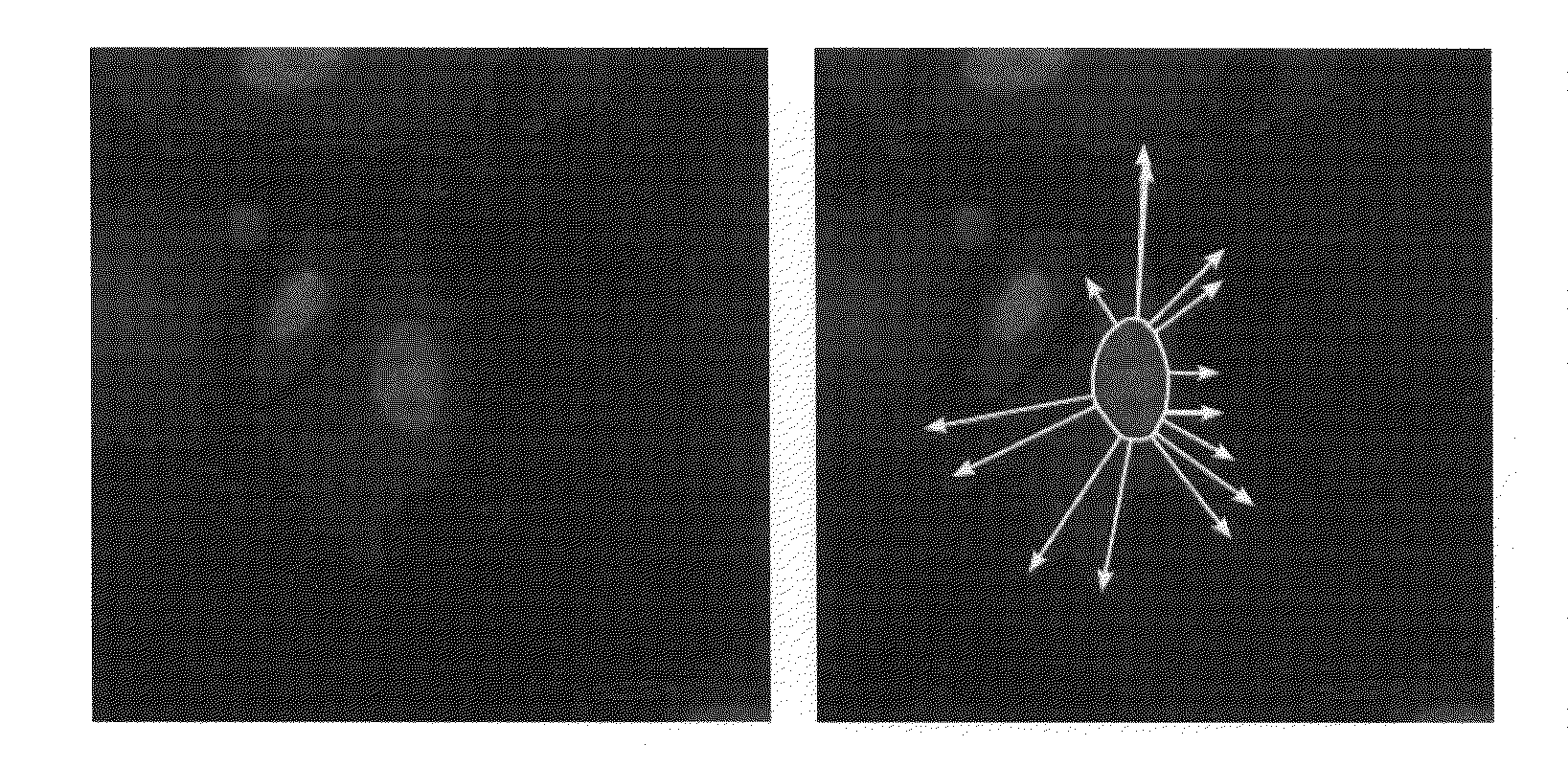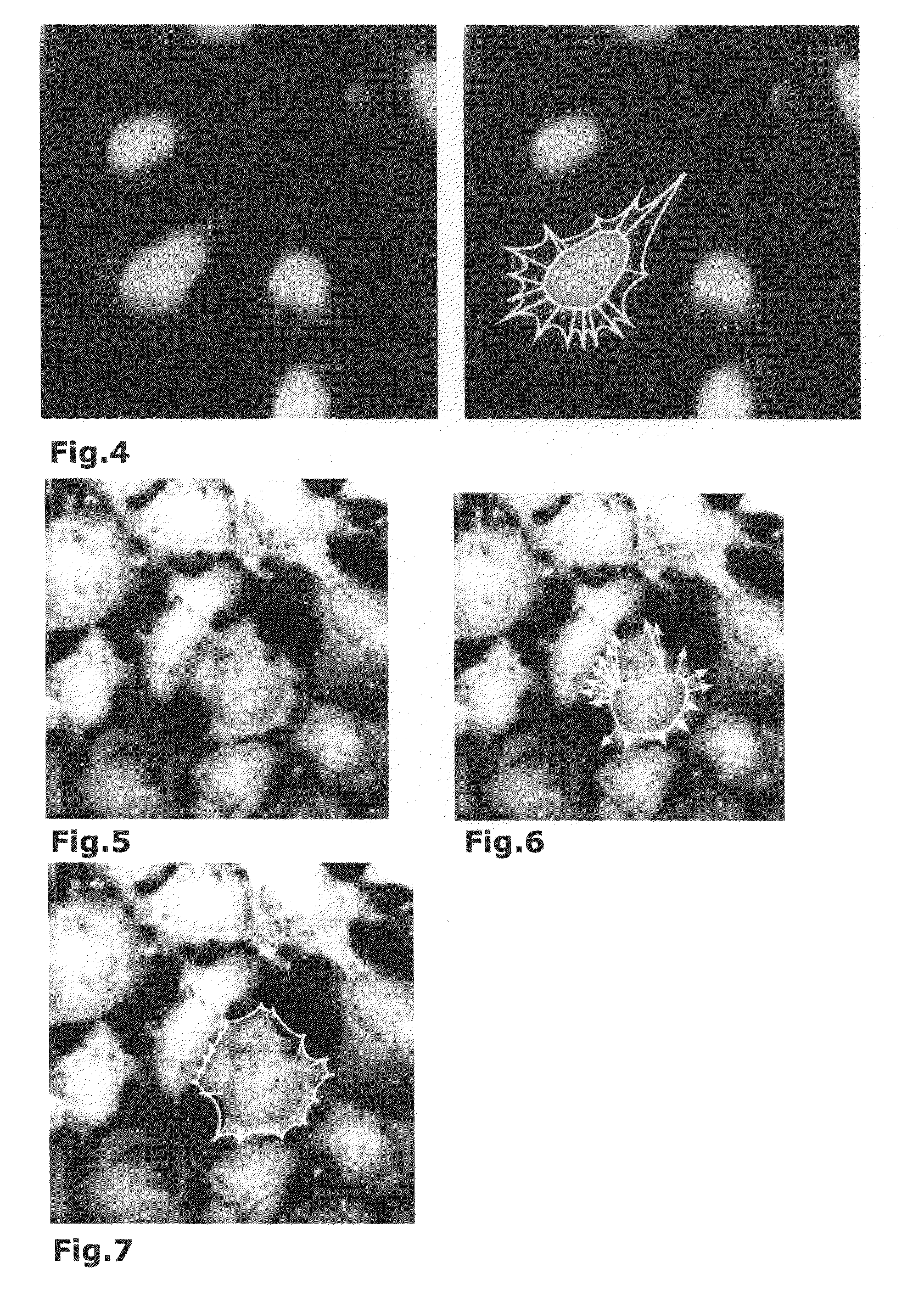Method for Detecting Contours in Images of Biological Cells
- Summary
- Abstract
- Description
- Claims
- Application Information
AI Technical Summary
Benefits of technology
Problems solved by technology
Method used
Image
Examples
embodiment 1
[0052]The model of an adherent cell presented herein puts emphasis on the calculation of the membrane, which, die to the data being present in the second dimension, means a line. At the same time, a simple inner structure for the construction of a cell is proposed.
[0053]Morphology of the Cell
[0054]The shape of a cell substantially results from the cytoskeleton, a combination of fibers internal to the cell, on the one hand, and the membrane, which is a bordering surface enclosing the cell, on the other hand. The skeleton is made from a framework of fibers connected at discrete points. Terminal points of the fibers penetrate the membrane and, by means of receptors, form a connection to the surrounding tissue or to the substrate. As used in the present embodiment, the terms inner and outer adhesion points refer to the adhesion points among the fibers or to the connection points of the fibers and materials surrounding the cell. Fibers having an outer adhesion point may often be consider...
embodiment 2
[0084]In less dense monolayers cells grow with a relatively high degree of freedom so that the cytoplasm with the surrounding membrane takes an irregular shape. The nucleus of a cell is then often offset from the centre and the tensions between outer adhesion points and the inside of the cell can no longer be described as a circular nucleus-related bundle of vectors.
[0085]A model that would be realistic in this sense should thus also include inner adhesion points besides the outer adhesion points.
[0086]Within a cell, the adhesion points are interconnected by actine fibers (Wang, Ning; Naruse, Keiji; Stamenovic, Dimitrije; Fredberg, Jeffrey J.; Mijailovich, Srboljub M.; Tolic-Norrelykke, Iva M.; Polte, Thomas; Mannix, Robert; Ingber, Donald E.: Mechanical behaviour in living cells consistent with the tensegrity model. In: Proc Natl Acad Sci USA (2001), July, No. 14, p. 7765-7770); they form the terminal points of those fibers. The connections are subject to mechanical forces (Wang, N...
embodiment 4
[0139]In a preferred embodiment of the present method an analysis was applied to further cell types. Concretely, those also were cells in cancerous bone s compared to the preceding Figures. In the cell tissue, the larger distances cause a higher degree of freedom of the formation of the cell contour of an individual cell. The above described landmarks were again used in the parametrization of splines by means of direction vectors (axes of growth). o longer be sorted in the order of their positions on the membrane contour; the present example further demonstrates that for cells with a spacious extension of the cytoplasm, a position of the axes of growth that is more independent from the nucleus—that is, a local orientation—is advantageous and can be determined with the method forming the basis of the disclosure.
[0140]thogonal to each other are determined. Thereafter, the set of landmarks was divided into two subsets A and B such that A included the marks situated in the first of the ...
PUM
 Login to View More
Login to View More Abstract
Description
Claims
Application Information
 Login to View More
Login to View More - R&D
- Intellectual Property
- Life Sciences
- Materials
- Tech Scout
- Unparalleled Data Quality
- Higher Quality Content
- 60% Fewer Hallucinations
Browse by: Latest US Patents, China's latest patents, Technical Efficacy Thesaurus, Application Domain, Technology Topic, Popular Technical Reports.
© 2025 PatSnap. All rights reserved.Legal|Privacy policy|Modern Slavery Act Transparency Statement|Sitemap|About US| Contact US: help@patsnap.com



